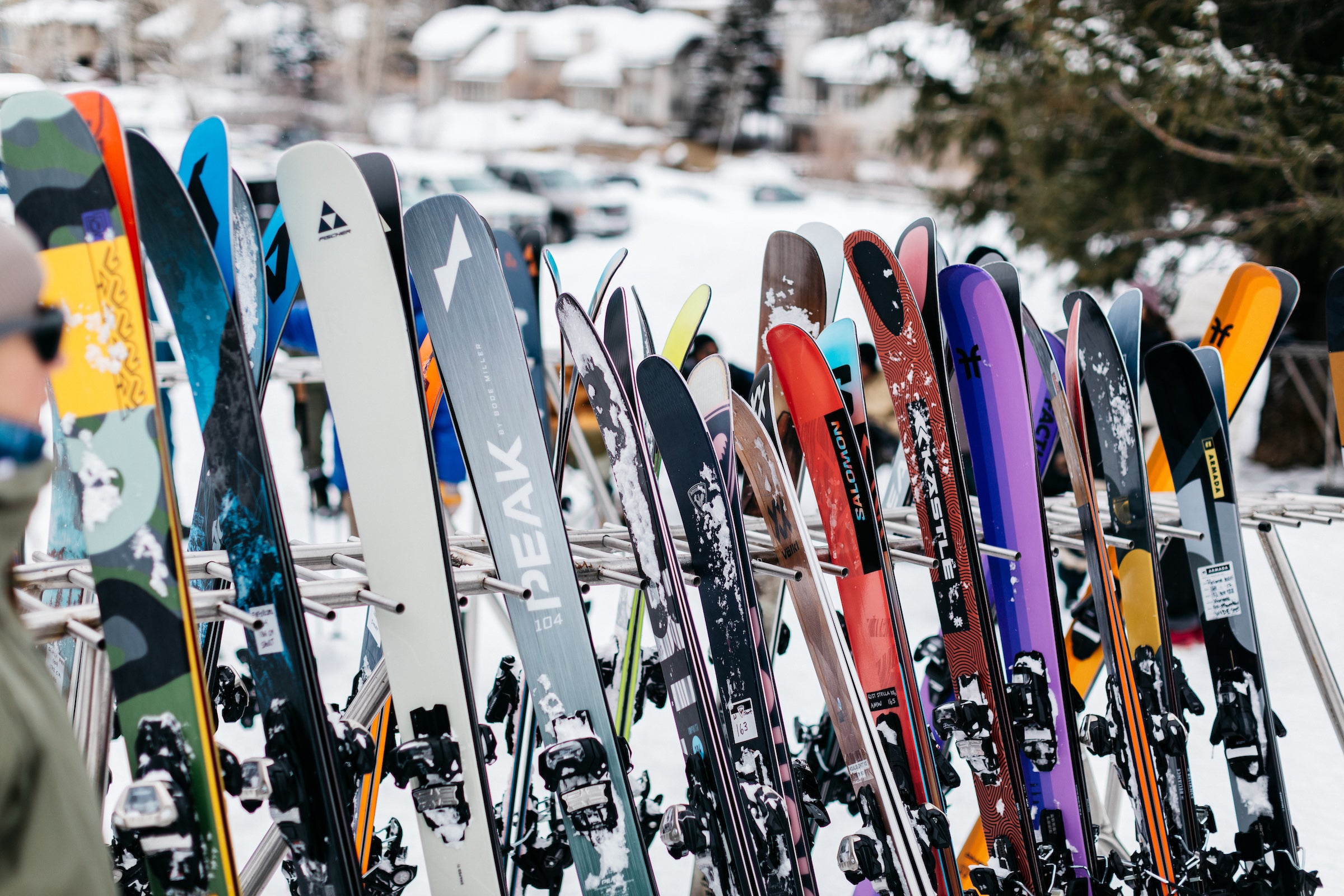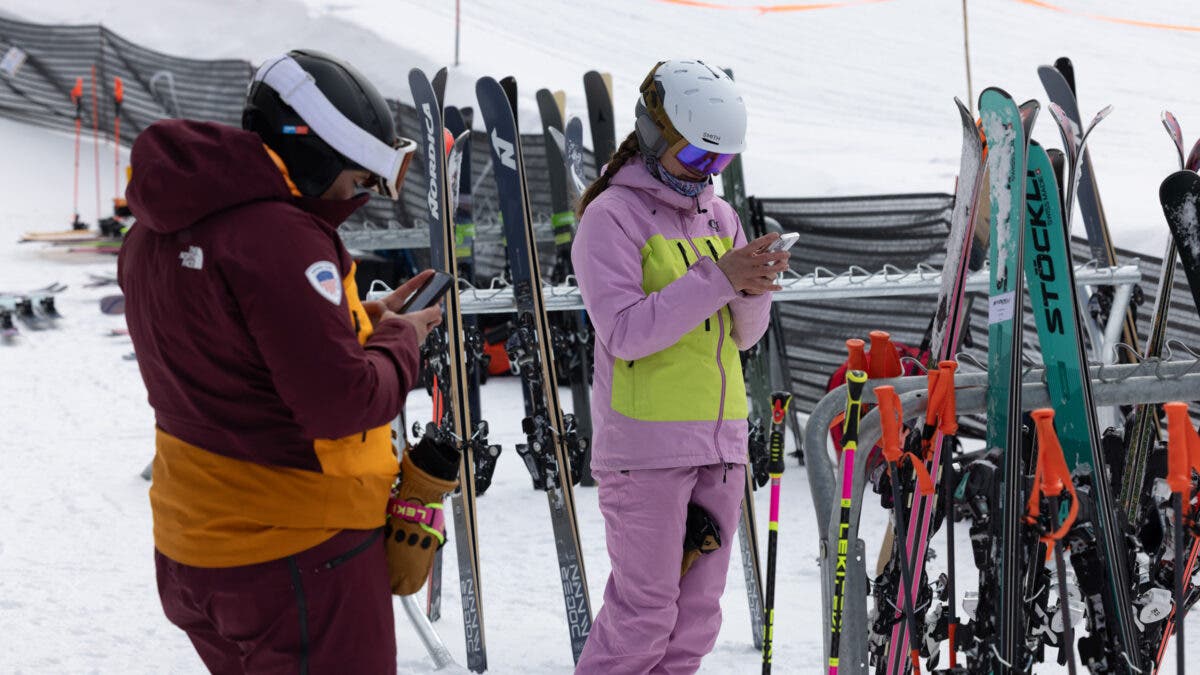How SKI Tests and Reviews Skis for the Annual Winter Gear Guide

(Photo: Ray J Gadd)
Table of Contents
Every year in early March, SKI gathers a team of expert testers to evaluate the newest skis that brands have been quietly developing behind the scenes. These are brand-new and updated models that won’t hit shop shelves until the following fall, meaning our testers are among the very first skiers anywhere to click into them.
Over the course of our annual test, they put each ski through its paces to evaluate how it performs in the real world—on groomers, in powder, and through all the mixed conditions you encounter over a season. Their insights and scores form the foundation of SKI’s Winter Gear Guide, giving readers an early, trustworthy look at the coming season’s gear.
How SKI Test Works
We group skis by category—waist width and intended application—so testers are comparing apples to apples. Categories include performance carving, frontside, all-mountain, all-mountain wide, powder, and backcountry. Each ski is evaluated across specific performance traits:
- Versatility
- Hard-Snow Integrity (not assessed in powder and backcountry categories)
- Crud Performance
- Quickness
- Responsiveness
- Stability at Speed
- Carving
- Playfulness
- Forgiveness
- Flotation (not assessed in carving and frontside categories)
Testers take each ski for multiple runs, skiing them hard, skiing them like intermediates, and forcing them through variable terrain and snow conditions. After every run, they fill out a digital scorecard detailing their observations. That feedback determines which skis earn a spot in SKI’s Winter Gear Guide.

We consider each ski’s overall performance, but we also look closely at how it scores in specific performance traits. This helps us highlight not only the most versatile, do-it-all skis, but also those that shine in a particular area—perfect for skiers with specialized preferences. If a ski doesn’t make the grade, we leave it out—plain and simple.
Understanding SKI’s Scoring Criteria
Every ski we test is evaluated on a set of performance traits that reflect how it handles in the real world. Here’s a quick guide to what our scoring categories mean, and what testers are looking for when they record their impressions.
| Scoring Criterion | Definition | Ski Characteristics |
| Hard-Snow Integrity | How confidently does the ski hold an edge on groomers, firm snow, or ice? | Skis with metal in the core and more camber typically grip better and respond more predictably on hard surfaces. |
| Carving | How easily and smoothly does the ski roll onto edge and carve an arc? | Narrower skis with defined hourglass shapes, traditional camber, and heavy metals are built to shine here. |
| Versatility | Can the ski handle everything from groomers to bumps, crud, and powder? | The most versatile skis perform consistently across varied conditions and terrain, adapting to different turn shapes and skiing styles. Middle-of-the-road waist widths and some rocker make a ski more adaptable. |
| Crud Performance | How well does the ski manage chopped-up snow off-piste? | Heavier skis with generous tip and tail rocker tend to smooth out rough snow and plow through clumps with power and predictability. |
| Stability at Speed | Does the ski inspire confidence when you open it up? | Stable skis feel smooth and reliable at higher speeds and in longer turns. Metal, camber, and a larger turning radius generally boost stability. |
| Quickness | How quickly can the ski transition from edge to edge, from turn shape to turn shape? | Lighter skis with narrower waists and shorter turn radii transition edge-to-edge quickly, making them ideal for tight terrain or short turns. |
| Playfulness | Does the ski feel lively and energetic? | Wood cores with responsive materials like poplar tend to create a more playful feel, while damper skis with lots of metal emphasize smoothness over energy. |
| Flotation | How well does the ski stay on top of deep snow? | Wider waists, generous rocker, and light constructions help skis float in powder and stay maneuverable when conditions are soft. |
| Forgiveness | How user-friendly is the ski for a range of abilities? | Forgiving skis are easier to bend, pivot, and course-correct, even with imperfect technique. Lighter builds and rocker promote forgiveness, while stiff, metal-heavy constructions tend to be less forgiving. |
| Responsiveness | How quickly and predictably does the ski react to skier input? | Responsive skis offer lively feedback and energy. Core materials, flex pattern, and effective edge all influence how reactive a ski feels underfoot. |
Where We Test
We choose test locations that offer reliable snow, varied terrain, and efficient logistics so our team can evaluate a wide range of skis in just a couple of weeks. This year, we headed to Montana, a state with more than a dozen ski areas and a reputation for diverse mountains and uncrowded slopes.
Our main base of operations for the 2025 SKI Test was Big Sky Resort, Montana’s crown jewel. With its nearly 6,000 acres of terrain and everything from long, high-speed groomers to steep, technical descents, it was the perfect setting for testing carving, frontside, and all-mountain skis. For a week, we lapped Big Sky’s lifts, gathering hundreds of data points while pushing the latest skis to their limits.
Once we’d wrapped up there, we shifted gears and headed to Bridger Bowl, known for its legendary Ridge terrain and consistent snowfall. Its spicy freeride terrain and deep powder made it the ideal proving ground for powder skis, letting our testers evaluate flotation, maneuverability, and performance in soft snow conditions.
Finally, we made our way to Red Lodge Mountain, which offers lift-served access to backcountry-like terrain without the need for long approaches or skin tracks. There, we efficiently tested backcountry skis in variable snowpack and challenging conditions that ski tourers encounter in the wild.
By moving between these three distinct Montana resorts, we were able to test each ski type in its natural habitat—ensuring that when we recommend a ski, it’s been put through the exact conditions it was designed for.
Who Tests the Skis?
Our team is a carefully curated mix of instructors, shop owners, ex-racers, bootfitters, and freeride competitors. This year’s lineup included 18 men and 12 women, all of whom bring deep experience in evaluating skis. Testing 15 to 20 skis in a day can be overwhelming for the uninitiated, but our seasoned testers know exactly what to look for—and how to communicate it clearly.
Why SKI’s Test Results Are Credible
SKI’s test is entirely objective. There’s no pay-to-play, no ad dollars influencing results, and no medals handed out to the highest bidder. We invite the heavy hitters—the Nordicas, Blizzards, Völkls, and Rossignols—but we also make room for smaller and boutique brands like Faction, DPS, 4FRNT, Line, and Icelantic. This mix ensures we’re testing and reviewing the same skis you’ll see on shop shelves and in lift lines. Each brand is allowed to enter one ski per category, which keeps the field fair and the focus on the very best each company has to offer. We do not charge brands to participate, so our test has zero financial barriers to entry; the only thing that matters is how the skis perform on snow.
We don’t just report scores; we provide the data and explain exactly what we’re looking for in each ski. Testing skis is inherently subjective, and we’re honest about that—but by combining decades of experience, rigorous methodology, and transparency, SKI delivers the most reliable and insightful ski reviews in the industry.
More from the 2026 Gear Guide
The Best All-Mountain Skis
The Best Women’s All-Mountain Skis







